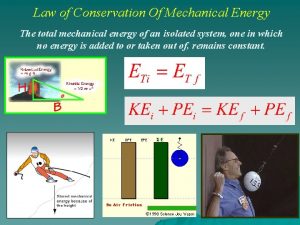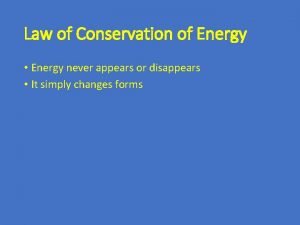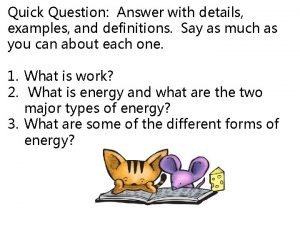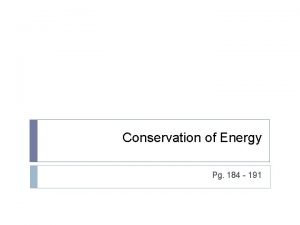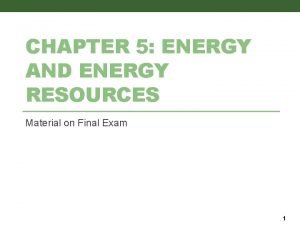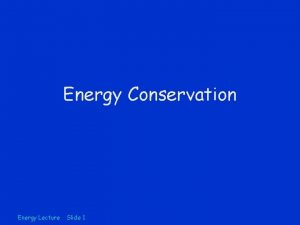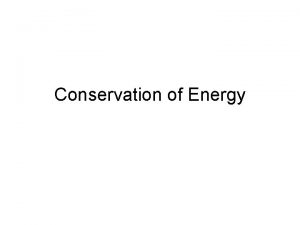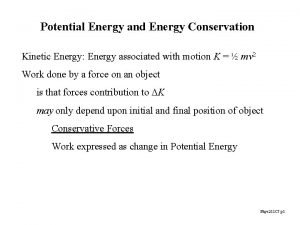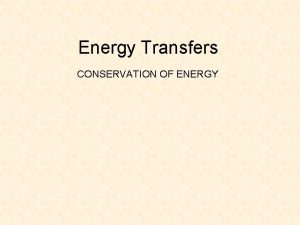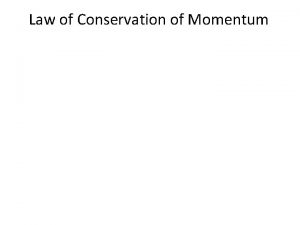CONSERVATION OF ENERGY The Law of Conservation of













- Slides: 13

CONSERVATION OF ENERGY The Law of Conservation of Energy In an isolated system, the total amount of energy is conserved Equation: Ui + KEi + Wc = Uf + KEf + Wn Wc = work done by conservative forces (adds nrg to the system) Wn = work done by non-conservative forces (removes nrg from the system)

You throw a rock straight up at a frisbee resting in a tree. If the rock’s speed as it reaches the frisbee is 4. 0 m/s, what was its speed as it left your hand 2. 8 m below? Kinematics / Dynamics Given: Equation: vf = 4. 0 m/s vf 2 = vi 2 + 2 a d d = 2. 8 m a = -9. 8 m/s 2 Substitute: (4. 0)2 = vi 2 + 2(-9. 8)(2. 8) Solve: vi = 8. 4 m/s

You throw a rock straight up at a frisbee resting in a tree. If the rock’s speed as it reaches the frisbee is 4. 0 m/s, what was its speed as it left your hand 2. 8 m below? 40 kg Work / NRG BEFORE Equation: AFTER KEf = ½mvf 2 Uf = mgh Substitute: KEi = ½mvi 2 Ui = 0 Wc = 0 Wn = 0 Ui + KEi + Wc = Uf + KEf + Wn KEi = Uf + KEf ½mvi 2 = mgh + ½mvf 2 ½mvi 2 = m(9. 8)(2. 8) + ½m(4. 0)2 ½mvi 2 = 27. 44 m + 8 m ½mvi 2 = 35. 44 m Solve: vi = 8. 4 m/s

A cannonball is shot off a 60 m tall cliff with a velocity of 40 m/s at 37 degrees. With what speed does it hit the ground? Kinematics / Dynamics Given: vi = 40 m/s @ 37° dy = -60 m ay = -9. 8 m/s 2 Equations: viy = vi (sin θ) 40(sin 37) = 24 m/s vx = vi (cos θ) 40(cos 37) = 32 m/s vfy 2 = viy 2 + 2 ay dy 32. 0 41. 8 vfy 2 = (24)2 + 2(-9. 8)(-60) vfy = - 41. 8 m/s vf = 52. 6 m/s vfx = 32. 0 m/s (since x-velocity is constant)

A cannonball is shot off a 60 m tall cliff with a velocity of 40 m/s at 37 degrees. With what speed does it hit the ground? Work / NRG BEFORE Equation: AFTER KEi = ½mvi 2 Ui = mgh Ui + KEi + Wc = Uf + KEf + Wn KEi + Ui = KEf ½mvi 2 + mgh = ½mvf 2 Substitute: ½mvf 2 Wc = 0 Wn = 0 KEf = Uf = 0 ½m(40)2 + m(9. 8)(60) = ½mvf 2 vf = 52. 6 m/s

A person on a bicycle traveling at 10. 0 m/s on a horizontal surface stops pedaling as she starts up a hill inclined at 3. How far up the incline will she travel before stopping? (neglect friction) Kinematics / Dynamics FN Fll = Fg(sin θ) = Fg(sin 3) = m(9. 8)(sin 3) = 0. 513 m Fll Fg a ΣF = ma ΣF = Fll Given: vi= 10 m/s vf= 0 m/s a = -0. 513 m/s 2 Substitute: Equation: vf 2 = vi 2 + 2 a d (0)2 = (10)2 + 2(-0. 513)( d ) ma = Fll d = 97. 5 m ma = 0. 513 m a = 0. 513 m/s 2

A person on a bicycle traveling at 10. 0 m/s on a horizontal surface stops pedaling as she starts up a hill inclined at 3. How far up the incline will she travel before stopping? (neglect friction) Work / NRG BEFORE Equation: AFTER Ui + KEi + Wc = Uf + KEf + Wn KEf = 0 Uf = mgh KEi = Uf ½mvi 2 = mgh Substitute: KEi = ½mvi 2 Ui = 0 Wc = 0 Wn = 0 h d d (sin θ) = h d (sin 3) = 5. 1 d = 97. 5 m ½m(10)2 = m(9. 8)(h) h = 5. 1 m This is the height, determine d with trig

A 1200 kg elevator must be lifted by a cable that causes the elevator’s speed to increase from zero to 4. 0 m/s as it rises 6. 0 m. What is the tension in the cable? Kinematics / Dynamics FT a ΣF = ma ma = FT - Fg ΣF = FT - Fg 1200 a = FT – 11, 760 Given: vi= 0 m/s 1200(1. 33) = FT – 11, 760 vf= 4. 0 m/s FT = 13, 360 N d = 6. 0 m Fg Equation: vf 2 = vi 2 + 2 a d Substitute: (4. 0)2 = (0)2 + 2(a)(6. 0 ) a = 1. 33 m/s 2

A 1200 kg elevator must be lifted by a cable that causes the elevator’s speed to increase from zero to 4. 0 m/s as it rises 6. 0 m. What is the tension in the cable? Equation: Work / NRG BEFORE AFTER Ui + KEi + Wc = Uf + KEf + Wn ½mvf 2 KEf = Uf = mgh WC = Uf + KEf FT d = mgh + ½mvf 2 Substitute: FT(6. 0) = (1200)(9. 8)(6. 0) + ½(1200)(4. 0)2 KEi = 0 Ui = 0 Wc = FT d Wn = 0 FT = 13, 360 N

A 7. 00 kg mass is connected to a 4. 50 kg mass by a rope passed over a frictionless pulley. The system is released from rest and the 7. 00 kg mass falls 3. 0 meters. What is its speed at this point? Kinematics / Dynamics a Given: vi = 0 m/s a = - 2. 10 m/s 2 d = - 3. 0 m Equation: vf 2 = vi 2 + 2 a d FT Fg 1 a FT Fg 2 ΣF = m 1 a ΣF = FT – Fg 1 ΣF = m 2 a ΣF = Fg 2 – FT Substitute: (vf)2 = (0)2 + 2(-2. 10)(-3. 0) v = - 3. 6 m/s m 1 a = FT – Fg 1 7 a = 68. 6 –(4. 5 a + 44. 1) 4. 5 a = FT – 44. 1 a = 2. 10 m/s 2 m 2 a = Fg 2 - FT 7 a = 68. 6 - FT FT = 4. 5 a + 44. 1

A 7. 00 kg mass is connected to a 4. 50 kg mass by a rope passed over a frictionless pulley. The system is released from rest and the 7. 00 kg mass falls 3. 0 meters. What is its speed at this point? Work / NRG BEFORE AFTER Equation: Ui + KEi + Wc = Uf + KEf + Wn Ui = Uf + KEf KEi = 0 Ui = m 2 gh KEf = ½m 1 v 2 Uf = m 1 gh Wc = 0 Wn = 0 m 2 gh = m 1 gh + ½m 1 v 2 + ½m 2 v 2 KEf = ½m 2 v 2 Uf = 0 Substitute: (7)(9. 8)(3) = (4. 5)(9. 8)(3) + ½(4. 5)(v)2 + ½(7)(v)2 v = 3. 6 m/s

A rope exerts a 345 N force pulling a 60 kg skier upward along a hill inclined at 25 degrees. If the skier started from rest, calculate her speed after moving 100 m up the slope. The snow exerts a frictional force of 50 N on the skier. Kinematics / Dynamics FT FN f Fll Fg a ΣF = ma ΣF = FT – Fll – f Fll = Fg(sin θ) = 588(sin 25) = 248 N Given: vi = 0 m/s a = 0. 78 m/s 2 d = 100 m Equation: vf 2 = vi 2 + 2 a d Substitute: vf 2 = (0)2 + 2(0. 78)(100) v = 12. 5 m/s ma = FT – Fll – f (60)a = 345 – 248 - 50 a = 0. 78 m/s 2

A rope exerts a 345 N force pulling a 60 kg skier upward along a hill inclined at 25 degrees. If the skier started from rest, calculate her speed after moving 100 m up the slope. The snow exerts a frictional force of 50 N on the skier. Equation: Work / NRG BEFORE AFTER KEf = ½mv 2 Uf = mgh Ui + KEi + Wc = Uf + KEf + Wn WC = Uf + KEf + Wn FTΔd = mgh + ½mv 2 + fΔd Substitute: (345)(100) = (60)(9. 8)(42) + ½(60)(v)2 + (50)(100) KEi = 0 Ui = 0 h d v = 12. 5 m/s Wc = FTΔd Wn = f Δd The d is 100 m → determine the height with trig d (sin θ) = h 100 (sin 25) = h h = 42 m
 Conservation of mechanical energy theorem
Conservation of mechanical energy theorem Explain the law of conservation of mechanical energy
Explain the law of conservation of mechanical energy Law of conservation of energy worksheets
Law of conservation of energy worksheets Energy conservation law
Energy conservation law The law of conservation of energy states that
The law of conservation of energy states that Energy conservation law
Energy conservation law Formula for total mechanical energy
Formula for total mechanical energy Natural science grade 7 energy and change
Natural science grade 7 energy and change The law of conservation of energy states that
The law of conservation of energy states that Potential vs kinetic energy
Potential vs kinetic energy Conservation of energy
Conservation of energy Law of conservation of energy
Law of conservation of energy The law of conservation of energy states that
The law of conservation of energy states that Law of conservation of energy
Law of conservation of energy

